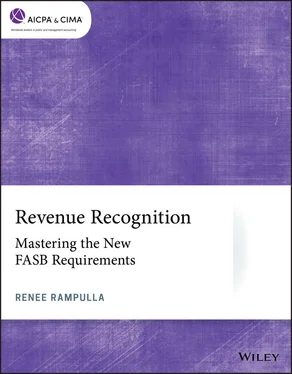Advertising costs: This change describes how entities that previously capitalized advertising costs in accordance with FASB ASC 340-20 would now apply the capitalization guidance in FASB ASC 340-40.
Fixed-odds wagering contracts in a casino industry: This ASU created a new FASB ASC 924-815, which excludes fixed-odds wagering contracts from its scope, and therefore fixed-odds wagering contracts in a casino industry are within the scope of FASB ASC 606.
Any changes brought about by the issuance of this ASU correspond to the applicable existing transition and effective dates of ASU No. 2014-09.
ASU No. 2017-10, Service concession arrangements (Topic 853): Determining the customer of the operation services (a consensus of the FASB Emerging Issues Task Force)
This ASU addresses service concession arrangements and specifically states that an operating entity shall account for revenue from service concession arrangements in accordance with FASB ASC 605 on revenue recognition or FASB ASC 606 on revenue from contracts with customers, as applicable. When applying FASB ASC 605 or FASB ASC 606, an operating entity shall consider the grantor to be the customer of its operation services in all cases for service concession arrangements within the scope of FASB ASC 853, Service Concession Arrangements . Any changes brought about by the issuance of this ASU correspond to the applicable effective dates of ASU No. 2014-09.
ASU No. 2018-08, Not-for-Profit Entities (Topic 958): Clarifying the scope and the accounting guidance for contributions received and contributions made
This ASU revised the scope and scope exception of FASB ASC 606 by stating that an entity shall consider the guidance in FASB ASC 958-605 when determining whether a transaction is a contribution within the scope of FASB ASC 958-605 or a transaction within the scope of FASB ASC 606.
Any changes brought about by the issuance of this ASU, relating to FASB ASC 606, correspond to the applicable effective dates of ASU No. 2014-09.
ASU No. 2018-18, Collaborative arrangements (Topic 808): Clarifying the interaction between Topic 808 and Topic 606
This ASU clarifies when certain transactions between collaborative arrangement participants should be accounted for under FASB ASC 606. Specifically, when the collaborative arrangement participant is a customer in the context of a unit of account.
 Key point
Key point
Consider reviewing and adopting the guidance in FASB ASC 606 directly from the guidance residing in FASB ASC instead of reviewing each individual related ASU because the codification complies all of the applicable guidance.
Scope and scope exceptions
Within the scope of FASB ASC 606
FASB ASC 606 applies to any entity that enters into a contract with a customer to transfer goods or services, including the transfer of nonfinancial assets that are not within the scope of other authoritative guidance. The scope of FASB ASC 606 is very broad; entities may find that some parts of a contract with a customer are within the scope of FASB ASC 606 and other parts fall within the scope of other FASB ASC topics.
An entity will need to consider the guidance in FASB ASC 958-605 on not-for-profit entities—revenue recognition—contributions when determining whether a transaction is a contribution within the scope of FASB ASC 958-605 or a transaction within the scope of FASB ASC 606.
Collaborative arrangements
An entity shall apply the guidance in FASB ASC 606 to a contract (other than those contracts outside the scope of FASB ASC 606), only if the counterparty to the contract is a customer. A customer is a party that has contracted with an entity to obtain goods or services that are an output of the entity’s ordinary activities in exchange for consideration.
Contracts partially within the scope of FASB ASC 606
A contract with a customer may be partially within the scope of FASB ASC 606 and partially within the scope of other FASB ASC topics. When this occurs,
if the other FASB ASC topic specify how to separate and measure one or more parts of the contract, apply that guidance first. An entity should exclude from the transaction price the amount of the part (or parts) of the contract that are initially measured in accordance with other FASB ASC topics and allocate to other parts of the contract the amount of the transaction price that remains (if any) to each performance obligation within the scope of FASB ASC 606.
if the other FASB ASC topics do not specify how to separate and initially measure one or more parts of the contract, apply the initial measurement guidance in FASB ASC 606.
The following are outside of the scope of FASB ASC 606:
Lease contracts within the scope of FASB ASC 840, Leases, and when effective, FASB ASC 842, Leases
Contracts within the scope of FASB ASC 944
Certain financial instruments and other contractual rights or obligations within the scope of the following:FASB ASC 310, ReceivablesFASB ASC 320, Investments - Debt and Equity SecuritiesFASB ASC 321, Investments - Equity SecuritiesFASB ASC 323, Investments - Equity Method and Joint VenturesFASB ASC 325, Investments - OtherFASB ASC 405, LiabilitiesFASB ASC 470, DebtFASB ASC 815FASB ASC 825, Financial InstrumentsFASB ASC 860, Transfers and Servicing
Guarantees other than product or service warranties within the scope of FASB ASC 460
Nonmonetary exchanges between entities in the same line of business to facilitate sales to customers (i.e., two oil entities that agree to an exchange of oil to fulfill a demand from their customers in different specified locations on a timely basis)
 Example 1-1 Scope and scope exceptions
Example 1-1 Scope and scope exceptions
Sometimes parts of a contract with a customer are within the scope of FASB ASC 606 whereas other parts of that same contract fall outside the scope of FASB ASC 606 and within the scope of other FASB ASC topics. For example, consider the following:
Able Company entered into a written agreement with its customer Hanson Inc. to lease a copy machine for a period of three years, provide maintenance services on the copy machine, and supply the customer with toner and paper during the same three-year period.
The revenue Able Company receives from the leasing of the copy machine to Hanson Inc. is within the scope of FASB ASC 840 (or 842, when effective), whereas the revenue received from both the maintenance services and the monthly supply of toner and paper are clearly within the scope of FASB ASC 606.
FASB ASC 606 provides a principle-based framework by introducing core principles that an entity should apply in order to recognize revenue. Keep in mind that these core principles have replaced all industryspecific revenue recognition guidance, unless that guidance is specifically scoped out of the new standard. This is significantly different from the way in which many entities have recognized revenue in the past, which is why FASB has stated that the new revenue recognition standard is the most significant change to accounting; only second to FASB ASC. In order to recognize revenue, an entity should apply the following five steps (core principles):
Identify the contract(s) with a customer.
Читать дальше

 Key point
Key point Example 1-1 Scope and scope exceptions
Example 1-1 Scope and scope exceptions










